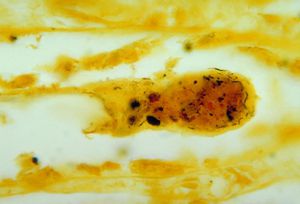Leptospira Interrogans: Difference between revisions
Egratke4272 (talk | contribs) (Created page with "{{Uncurated}} This is the leader section -- here you can write a short description of your topic and why it is interesting. The goal is for this to quickly cover the main idea...") |
Egratke4272 (talk | contribs) No edit summary |
||
| Line 16: | Line 16: | ||
==Mechanisms of Infection== | ==Mechanisms of Infection== | ||
<br><i>L. interrogans</i> can be spread through the bodily fluids, excluding the saliva, of infected animals. The bacteria can enter the body through skin or mucous membranes and via consumption of contaminated water. Infected wild and domestic animals may continue to excrete the bacteria into the environment for up to several years and the bacteria can remain in soil and water for months at a time. | |||
==Symptoms and Impact== | ==Symptoms and Impact== | ||
<br><b>Humans</b> | <br><b>Humans</b> | ||
[[File:Leptospirosis in kidney.jpg|300px|thumb|Leptospirosis | [[File:Leptospirosis in kidney.jpg|300px|thumb|right|Leptospirosis infected kidney tissue|alt=Leptospirosis in kidney.jpg]] | ||
<br><b>Other Mammals</b> | <br><b>Other Mammals</b> | ||
| Line 29: | Line 31: | ||
==Current Research== | ==Current Research== | ||
==Further Reading== | ==Further Reading== | ||
Revision as of 09:31, 24 March 2015
This is the leader section -- here you can write a short description of your topic and why it is interesting. The goal is for this to quickly cover the main ideas of your topic and get the reader interested in reading the rest!
Classification
Higher Order Taxa
Bacteria; Spirochaetes; Spirochaetia; Spirochaetales; Leptospiraceae; Leptospira
Species
Leptospira interrogans
Cell Structure and Metabolism
Leptospira interrogans is a gram negative bacteria. The cell is thin and spiral shaped with a hook on each end. It is motile and possesses two periplasmic flagella. The L. interrogans species can be broken down into roughly 250 serovars. Leptospiral serovar diversity results from structural differences in carbohydrate component of lipopolysaccharides. Many serovars are adapted for specific mammalian reservoir hosts. Leptospira interrogans is an aerobic bacteria and possesses both catalase and oxidase enzymes and does not ferment carbohydrates.
Genomic Structure
Mechanisms of Infection
L. interrogans can be spread through the bodily fluids, excluding the saliva, of infected animals. The bacteria can enter the body through skin or mucous membranes and via consumption of contaminated water. Infected wild and domestic animals may continue to excrete the bacteria into the environment for up to several years and the bacteria can remain in soil and water for months at a time.
Symptoms and Impact
Humans
Other Mammals
Prevention of Leptospirosis
Due to the common transmission of L. interrogans via rodents, one of the most effective methods of prevention in animals is minimizing rodent populations near animal residences. Pets can also be vaccinated against Leptospirosis, but the vaccine only inhibits a handful of serovars. There is no formal method of Leptospirosis prevention in humans. Chance of contraction can be reduced by minimizing or avoiding direct contact with animal excrement or water contaminated with animal waste.
Current Research
Further Reading
[Sample link] Ebola Hemorrhagic Fever—Centers for Disease Control and Prevention, Special Pathogens Branch
References
Edited by Emily Gratke, a student of Nora Sullivan in BIOL168L (Microbiology) in The Keck Science Department of the Claremont Colleges Spring 2015.

